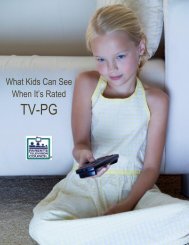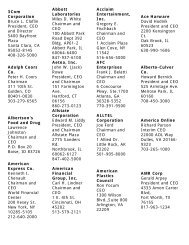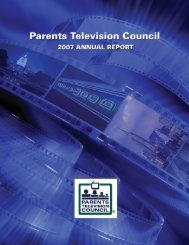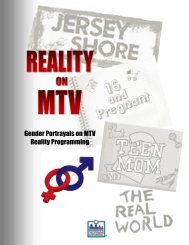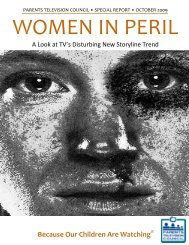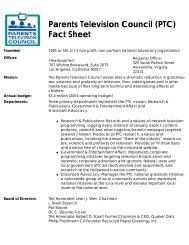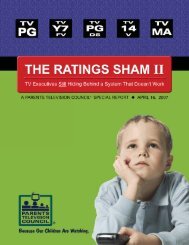The Ratings Sham - Parents Television Council
The Ratings Sham - Parents Television Council
The Ratings Sham - Parents Television Council
You also want an ePaper? Increase the reach of your titles
YUMPU automatically turns print PDFs into web optimized ePapers that Google loves.
THE RATINGS SHAM: TV Executives Hiding Behind a System That Doesn’t Work • <strong>Parents</strong> <strong>Television</strong> <strong>Council</strong> • April 2005 3<br />
THE RATINGS SHAM<br />
TV Executives Hiding Behind a System That Doesn’t Work<br />
I. BACKGROUND<br />
In America’s culture wars, Janet Jackson’s Super<br />
Bowl halftime performance was the shot heard<br />
‘round the world. Congress already was planning<br />
hearings to explore the issue of broadcast indecency,<br />
in large part because of the national outrage<br />
triggered by the Federal Communications<br />
Commission’s October 2003 ruling that Bono’s use<br />
of the “F-word” during the Golden Globes was not<br />
indecent, but by exposing her breast during the mostwatched<br />
TV event of the year to an audience that<br />
included millions of children, Jackson set off a<br />
powerful chain reaction. Hundreds of thousands of<br />
angry parents flooded CBS, the FCC, and<br />
Congressional offices with complaints. All of a<br />
sudden, curbing broadcast indecency was a numberone<br />
priority for everyone from lawmakers on Capitol<br />
Hill, to the FCC, to major broadcasters including<br />
Viacom and Clear Channel.<br />
Predictably, Hollywood soon started to push<br />
back. Last February, representatives from ABC, NBC,<br />
and Fox broadcast networks were called to present<br />
testimony before the House Subcommittee on<br />
Telecommunications and the Internet about the<br />
steps they intended to take to reduce the flow of<br />
indecent material over the broadcast airwaves. In<br />
their prepared statements and during the questionand-answer<br />
period that followed, Gail Berman,<br />
president of entertainment for Fox; Alex Wallau, the<br />
president of ABC; and Alan Wurtzel, president of<br />
research and media development for NBC all<br />
expressed support for the idea of educating<br />
consumers about how to use the TV ratings system<br />
and the V-chip to block offensive content. Not one<br />
of them discussed taking steps to reduce the volume<br />
of offensive material on their networks.<br />
“ABC believes strongly that we have a<br />
responsibility to enable our viewers to make<br />
informed choices about the programs they watch<br />
and those their children watch,” said ABC’s Wallau.<br />
“<strong>The</strong> V-chip can play a critical role in these choices.”<br />
<strong>The</strong> networks, it seems, are all about<br />
empowerment. But whatever happened to<br />
responsibility? Statements from some network<br />
executives prove that they have no intention of<br />
curbing indecent material on their networks; they<br />
never did. According to Broadcasting & Cable, “NBC<br />
said the FCC should review whether it should be<br />
enforcing any anti-indecency rules nowadays given<br />
that broadcast viewers have the option of using the<br />
V-chip to block channels they don’t want coming<br />
into their homes and that stations must now compete<br />
with raunchier, much less regulated pay-TV<br />
programming.”<br />
In NBC’s view (a view that no doubt is shared<br />
by many broadcast and basic cable networks) the<br />
V-chip exempts the networks from any responsibility<br />
or restraint with regard to program content. This is a<br />
very puzzling position indeed, considering NBC and<br />
NBC-owned cable channels have steadfastly refused<br />
to adopt the content descriptors that trigger the V-<br />
chip that might allow a parent to block out the<br />
offending material.<br />
<strong>The</strong> broadcast industry is hiding behind a<br />
system that doesn’t work, rather than taking the<br />
necessary steps to reduce the amount of violent and<br />
vulgar programming flooding into America’s living<br />
rooms on a nightly basis.<br />
○ ○ ○ ○ ○ ○ ○ ○ ○ ○ ○ ○ ○ ○ ○ ○ ○ ○ ○ ○ ○ ○ ○ ○ ○ ○ ○ ○ ○<br />
II. INTRODUCTION<br />
On February 29, 1996, TV executives<br />
announced they would rate entertainment<br />
programming so as to inform parents about its<br />
suitability for young viewers. <strong>The</strong> announcement was<br />
spurred not only by public demand for parentalguidance<br />
ratings, but also by the possibility that the<br />
federal government might impose a system if the<br />
industry didn’t. Under those circumstances, the<br />
television industry chose to regulate itself by<br />
adopting a voluntary ratings system.



